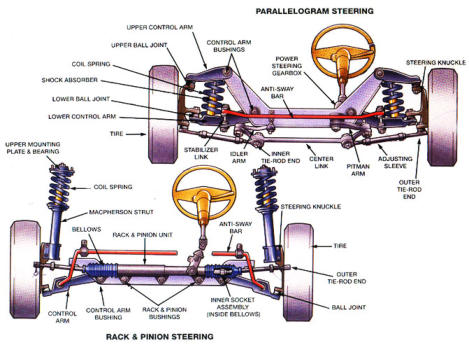


Dualtone Automotive 4745 Mission Bay Dr. San Diego, CA 92109 © Dualtone Automotive Inc. 2015
Serving San Diego Since 1946





The Parts That Hold It all Together
Suspension systems are made up of several components, all of which may benefit from a scheduled inspection even if your two-wheel or four-wheel drive vehicle is showing little sign of misalignment. A reliable system may produce an easy ride, but that is only half of its job. The other is to keep the vehicle stable and prevent it from losing its grip on the road. Parts to inspect include: • Sway bar or stabilizer bar • Inner and outer tie rod ends • Ball joints • Idler arm and pitman arm • Control arm bushings • Coil, leaf and air springs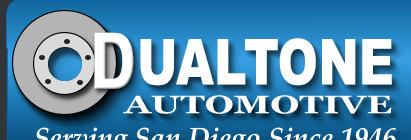
Phone: (858) 273-874 (619) 276-4525

8:00am-500pm
8:00am-200pm
Closed
At Dualtone we can handle cars that don’t handle well
Several warning signs can tell you when shock absorbers need replacing,
such as your car bottoms out over railroad tracks, speed bumps or dips in the
road or keeps bouncing well after the fact. Other signs are unusual noises over
bumps, excessive body lean in turns or that the front end of the car dives
sharply in hard braking. Because shocks wear out gradually, you might get used
to a looser, bouncier ride, much like you get used to longer stopping distances
as brake pads wear out.
One way to test shocks is to push down hard on each corner of a vehicle.
If the car continues to bounce after you let go, your shocks need replacing.
However, this test may require quite a bit of strength, and with many high-riding
SUVs and pickups it isn't easy to get the leverage you need.
Instead, you should have a qualified mechanic check your shock
absorbers when your car is on a lift, such as when you have tires rotated. The
mechanic will be able to see if there are major leaks (shock absorbers are filled
with fluid), worn mounts or bushings, or physical damage such as dents.
When you need to replace your shocks or struts can vary by vehicle and how and where you drive. If you frequently
drive over rough, pockmarked roads that put more stress on the shock absorbers, then you will probably need to replace them
more often than if you drive mainly on smooth pavement. Carrying heavy loads also will wear out shocks faster.
When you begin to notice your car or truck bouncing or nose-diving when you brake, it is time to call us at Dualtone of
San Diego. We excel at getting the right shock absorber and strut replacement for your foreign or domestic vehicle. Even if
you are not bobbing on the road, small changes in handling may indicate it is time for a check.
Shocks and struts
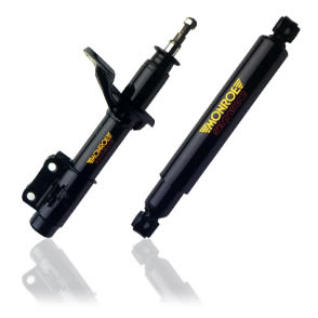
At Dualtone of San Diego, we understand you want to enjoy a smooth ride and great drivability from your car or truck. A key
to getting the best experience is regular maintenance and suspension repair when you need it. In an annual checkup, we will
inspect, adjust and fix any issues with front and rear suspension that could compromise your driving safety and pleasure.
We Repair CV Joints and Drive Axles in San Diego
At Dualtone of San Diego, our goal is to help keep your foreign or domestic auto or pickup in factory condition for as long as you own it. Any sort of daily driving puts stress on a vehicle. Axles are designed for different needs, but in general they stabilize a vehicle under conditions of speed and weight. Over time, parts may need attention. If an inspection shows a weakness in the system, it may be time for a CV axle replacement. Dualtone services all types of vehicles, including: • Rear-wheel drive (RWD) • Four-wheel drive (4WD) • Front-wheel drive (FWD)How They Work
An axle shaft is a narrow piece, like a pole, that connects a wheel to the gears in the transmission of your car or truck. In most FWD cars, the drive axle is split between two half axles, with differential and universal joints, or u-joints, in between. The constant velocity (CV) joint is a third piece that allows the wheels to move freely. This joint enables the shaft to rotate, transmitting power at a constant speed without causing an excess of friction and heat. When a boot, or grease container, leaks and the CV joint fails to be properly lubricated, it may eventually wear out and require a shaft assembly replacement.When to See a Pro for a Proper Fix
Sometimes it is clear when something is off, other times it is harder to tell. The following are some of the signs that something is off kilter with the suspension: • The road feels rough and the ride is jerky • The front end nose-dives when the car brakes • The car seems to drift or pull during turns • The tire tread is uneven • The shocks appear oily, indicating a leak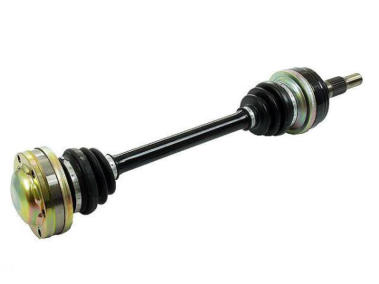
control arm bushings
Bushings are commonly found at hinge points in the suspension. Most
are designed to allow rotational movement while limiting lateral or side to
side motion. This movement allows the suspension parts to move freely, for
example, when traveling over a large bump, while minimizing transmission of
noise and small vibrations through to the chassis of the vehicle. Like all
rubber components they are susceptible to wear and contamination from oil
and the elements. Worn bushings can lead to clunking noises as well as
wheel misalignment.

Ball Joints
ball joints are spherical bearings that connect the control arms to the
steering knuckles .In automobile suspension, the two ball joints are called the
"upper ball joint" and "lower ball joint". Lower ball joints are typically larger and
wear out faster as the entire front end weight rests upon them. Over time ball
joints wear their sockets to the point where the ball is no longer held securely.
This wear can lead to bump steer, a condition in which the the vehicle will
change direction after hitting a patch of uneven road without input from the
driver, as well as increased tire wear.

Idler arms, pitman arms and tie rod ends
The two common types of steering systems in use
today are rack and pinion and parallelogram.
A parallelogram steering linkage is called such
because like its name sake the two sides of the linkage run
parallel to each other and are equal in distance. This type of
steering linkage uses four tie rods, one inner and one outer
on each side (left and right), a center link (which runs
between the tie rods), an idler arm on the passenger side,
and a pitman arm on the driver side. The pitman arm
attaches to the steering gear output shaft which is also
commonly called the pitman shaft. The pitman arm attaches
to the center link and is moved by turning the steering
wheel. The center link transfers the movement from the
pitman arm and pitman shaft to the idler arm on the
passenger side. The inner tie rods are mounted to the center
link and transfer steering motion to the steering arms and
outer tie rods. All of the joints which mount these
components are constructed of small ball and socket joints
to provide the necessary freedom of movement required to maintain control over the vehicle while it is in motion. The rack and
pinion system is simpler than the parallelogram design but it’s components have a similar design and therefore the common
weaknesses. Over time, the inner tie-rod ends wear and can cause excessive play in the steering linkage. Also, bellows boots
may become torn or dislodged from their seat. When bellows boots are torn, dirt or abrasives may enter the unit, accelerating
wear of rack-and-pinion seals and bushings. Routine inspection can identify damage early, before additional problems arise.
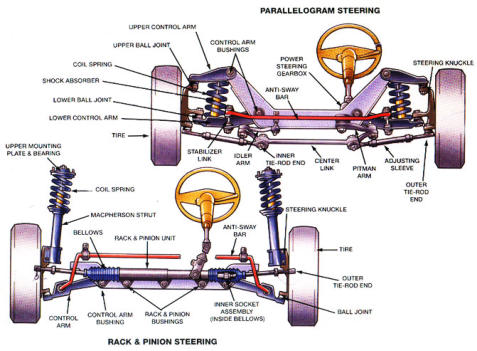




Dualtone Automotive 4745 Mission Bay Dr. San Diego, CA 92109 © Dualtone Automotive Inc. 2015
Serving San Diego Since 1946

The Parts That Hold It all Together
Suspension systems are made up of several components, all of which may benefit from a scheduled inspection even if your two-wheel or four-wheel drive vehicle is showing little sign of misalignment. A reliable system may produce an easy ride, but that is only half of its job. The other is to keep the vehicle stable and prevent it from losing its grip on the road. Parts to inspect include: • Sway bar or stabilizer bar • Inner and outer tie rod ends • Ball joints • Idler arm and pitman arm • Control arm bushings • Coil, leaf and air springsWe Repair CV Joints and Drive Axles in
San Diego
At Dualtone of San Diego, our goal is to help keep your foreign or domestic auto or pickup in factory condition for as long as you own it. Any sort of daily driving puts stress on a vehicle. Axles are designed for different needs, but in general they stabilize a vehicle under conditions of speed and weight. Over time, parts may need attention. If an inspection shows a weakness in the system, it may be time for a CV axle replacement. Dualtone services all types of vehicles, including: • Rear-wheel drive (RWD) • Four-wheel drive (4WD) • Front-wheel drive (FWD)How They Work
An axle shaft is a narrow piece, like a pole, that connects a wheel to the gears in the transmission of your car or truck. In most FWD cars, the drive axle is split between two half axles, with differential and universal joints, or u-joints, in between. The constant velocity (CV) joint is a third piece that allows the wheels to move freely. This joint enables the shaft to rotate, transmitting power at a constant speed without causing an excess of friction and heat. When a boot, or grease container, leaks and the CV joint fails to be properly lubricated, it may eventually wear out and require a shaft assembly replacement.
At Dualtone we can handle
cars that don’t handle well
At Dualtone of San Diego, we understand you want to
enjoy a smooth ride and great drivability from your car or truck.
A key to getting the best experience is regular maintenance
and suspension repair when you need it. In an annual
checkup, we will inspect, adjust and fix any issues with front
and rear suspension that could compromise your driving safety
and pleasure.
When to See a Pro for a Proper Fix
Sometimes it is clear when something is off, other times it is harder to tell. The following are some of the signs that something is off kilter with the suspension: • The road feels rough and the ride is jerky • The front end nose-dives when the car brakes • The car seems to drift or pull during turns • The tire tread is uneven • The shocks appear oily, indicating a leakShocks and struts
Several warning signs can tell you when shock absorbers
need replacing, such as your car bottoms out over railroad
tracks, speed bumps or dips in the road or keeps bouncing
well after the fact. Other signs are unusual noises over bumps,
excessive body lean in turns or that the front end of the car
dives sharply in hard braking. Because shocks wear out
gradually, you might get used to a looser, bouncier ride, much
like you get used to longer stopping distances as brake pads
wear out.
One way to test shocks is to push down hard on each
corner of a vehicle. If the car continues to bounce after you let
go, your shocks need replacing. However, this test may require
quite a bit of strength, and with many high-riding SUVs and
pickups it isn't easy to get the leverage you need.
Instead, you should have a qualified mechanic check
your shock absorbers when your car is on a lift, such as when
you have tires rotated. The mechanic will be able to see if
there are major leaks (shock absorbers are filled with fluid),
worn mounts or bushings, or physical damage such as dents.
When you need to replace your shocks or struts can vary
by vehicle and how and where you drive. If you frequently drive
over rough, pockmarked roads that put more stress on the
shock absorbers, then you will probably need to replace them
more often than if you drive mainly on smooth pavement.
Carrying heavy loads also will wear out shocks faster.
When you begin to notice your car or truck bouncing or
nose-diving when you brake, it is time to call us at Dualtone of
San Diego. We excel at getting the right shock absorber and
strut replacement for your foreign or domestic vehicle. Even if
you are not bobbing on the road, small changes in handling
may indicate it is time for a check.

control arm bushings
Bushings are commonly found at hinge points in the
suspension. Most are designed to allow rotational movement
while limiting lateral or side to side motion. This movement
allows the suspension parts to move freely, for example, when
traveling over a large bump, while minimizing transmission of
noise and small vibrations through to the chassis of the vehicle.
Like all rubber components they are susceptible to wear and
contamination from oil and the elements. Worn bushings can
lead to clunking noises as well as wheel misalignment.

Ball Joints
ball joints are spherical bearings that connect the control
arms to the steering knuckles .In automobile suspension, the two
ball joints are called the "upper ball joint" and "lower ball joint".
Lower ball joints are typically larger and wear out faster as the
entire front end weight rests upon them. Over time ball joints
wear their sockets to the point where the ball is no longer held
securely. This wear can lead to bump steer, a condition in which
the the vehicle will change direction after hitting a patch of
uneven road without input from the driver, as well as increased
tire wear.

Idler arms, pitman arms and tie rod ends
The two common types of steering systems in use today are
rack and pinion and parallelogram.
A parallelogram steering linkage is called such because like
its name sake the two sides of the linkage run parallel to each
other and are equal in distance. This type of steering linkage uses
four tie rods, one inner and one outer on each side (left and right),
a center link (which runs between the tie rods), an idler arm on
the passenger side, and a pitman arm on the driver side. The
pitman arm attaches to the steering gear output shaft which is
also commonly called the pitman shaft. The pitman arm attaches
to the center link and is moved by turning the steering wheel. The
center link transfers the movement from the pitman arm and
pitman shaft to the idler arm on the passenger side. The inner tie
rods are mounted to the center link and transfer steering motion
to the steering arms and outer tie rods. All of the joints which
mount these components are constructed of small ball and socket
joints to provide the necessary freedom of movement required to
maintain control over the vehicle while it is in motion. The rack
and pinion system is simpler than the parallelogram design but it’s
components have a similar design and therefore the common
weaknesses. Over time, the inner tie-rod ends wear and can
cause excessive play in the steering linkage. Also, bellows boots
may become torn or dislodged from their seat. When bellows
boots are torn, dirt or abrasives may enter the unit, accelerating
wear of rack-and-pinion seals and bushings. Routine inspection
can identify damage early, before additional problems arise.
